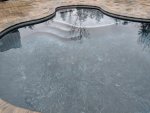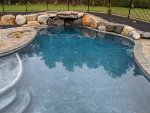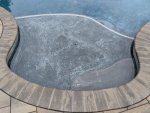When opening the pool this spring I found small chips missing in my sun shelf and a few rough white spots on the sides of the pool. Most chipping seems to be around the In floor cleaning heads but there are some very obvious ones on the shelf itself. The pool tech that opened the pool said it was most likely from freezing on the shelf. This was not the same tech that closed the pool who drained the water below the shelf and placed a insulated tarp (frost blanket) on the shelf and instructed me to keep the water level below the shelf for the winter which is what I did. This is the same thing he did the previous year and there were no issues the following spring. It looks like there is also chipping around the In floor heads in the bottom of the pool but it is just too chilly right now to get in and check any of the bottom for additional chipping. The area under where the chips came out is a dark Grey plaster color.
Would there be any other cause for this chipping out except freezing?
In reference to the rough spots. I have read the reports on here from onBalance However it is not clear to me what these could be. From my understanding Calcium nodules will have more of a raised feeling to them. These spots look exactly like the rest of the white spotting that has occurred on my med Grey plaster. They are about 1-2" and irregular in shape. Running my hand over them they appear to be either flush with the pool wall or perhaps very slightly indented. I can scratch them with my fingernail and see small amount of dust come off of them. Could these be scaling? I found 3 of these spots on the areas of the sides I can reach down into the chilly water. I can not test any deeper until things warm up a bit and since they look like my white spotting it is impossible to tell how many I have. The the Pic shows what most of my plaster now look like. All of those white spots are smooth to the touch except a small 1"-2" patch which is rough.
The other terminology that is unclear to me is if 'White spotting' Is referencing the same affect as mottling.
The plaster company is supposed to be coming out in 2-3 weeks to check out these issues.
Any information on these issues would be greatly appreciated .. Thanks, Rich.
------------------------------------------
Test Results 04-18-2019 @ 05:13 PM
------------------------------------------
Free Chlorine: 5.0
Combined Chlorine: 0.0
pH: 7.6
Total Alkalinity: 75
Calcium Hardness: 250
CYA: 35
Temperature: 57°F
CSI: -0.38
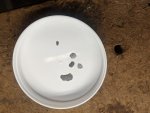
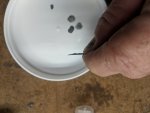
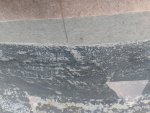
Would there be any other cause for this chipping out except freezing?
In reference to the rough spots. I have read the reports on here from onBalance However it is not clear to me what these could be. From my understanding Calcium nodules will have more of a raised feeling to them. These spots look exactly like the rest of the white spotting that has occurred on my med Grey plaster. They are about 1-2" and irregular in shape. Running my hand over them they appear to be either flush with the pool wall or perhaps very slightly indented. I can scratch them with my fingernail and see small amount of dust come off of them. Could these be scaling? I found 3 of these spots on the areas of the sides I can reach down into the chilly water. I can not test any deeper until things warm up a bit and since they look like my white spotting it is impossible to tell how many I have. The the Pic shows what most of my plaster now look like. All of those white spots are smooth to the touch except a small 1"-2" patch which is rough.
The other terminology that is unclear to me is if 'White spotting' Is referencing the same affect as mottling.
The plaster company is supposed to be coming out in 2-3 weeks to check out these issues.
Any information on these issues would be greatly appreciated .. Thanks, Rich.
------------------------------------------
Test Results 04-18-2019 @ 05:13 PM
------------------------------------------
Free Chlorine: 5.0
Combined Chlorine: 0.0
pH: 7.6
Total Alkalinity: 75
Calcium Hardness: 250
CYA: 35
Temperature: 57°F
CSI: -0.38





